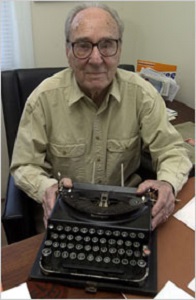De Britse schrijver en cameraman Jasper Fforde werd geboren op 11 januari 1961 in Londen. Zie ook alle tags voor Jasper Fforde op dit blog.
Uit: The Eye of Zoltar
“The first thing we had to do was catch the Tralfamo-saur. The obvious question, other than “What’s a Tralfa-mosaur?” was “Why us?” The answer to the first question was that this was a magical beast, created by some long-forgotten wizard when conjuring up weird and exotic creatures had been briefly fashionable. The Tralfamosaur is about the size and weight of an elephant, has a brain no bigger than a Ping-Pong ball, and can outrun a human. More relevant to anyone trying to catch one, Tralfamo-saurs aren’t particularly fussy about what they eat. And when they are hungry — which is much of the time — they are even less fussy. A sheep, cow, rubber tire, garden shed, antelope, smallish automobile, or human would go down equally well. In short, the Tralfamosaur is a lot like a Tyrannosaurus rex, but without the sunny disposition. And we had to capture it. Oh, and the answer to the “Why us?” question was that it was our fault the rotten thing had escaped. In case you’re new to my life, I’m sixteen, a girl, and an orphan — hey, no biggie; lots of kids don’t have par-ents here in the Ununited Kingdoms, because so many people have been lost in the endless Troll Wars these past sixty years. With lots of orphans around, there’s plenty of cheap labor. I got lucky. Instead of being sold into the garment, fast food, or hotel industry, I get to spend my six years of indentured servitude at Kazam Mystical Arts Management, a registered House of Enchantment run by the Great Zambini. Kazam does what all Houses of En-chantment used to do: rent out wizards to perform magi-cal feats. The problem is that in the past half century, magic has faded, so we are really down to finding lost shoes, rewiring houses, unblocking drains, and getting cats out of trees. It’s a bit demeaning for the once-mighty sorcerers who work for us, but at least it’s paid work. At Kazam I found out that magic has not much to do with black cats, cauldrons, wands, pointy hats, and broomsticks. No, those are only in the movies. Real magic is weird and mysterious, a fusion between science and faith.”
Jasper Fforde (Londen, 11 januari 1961)

